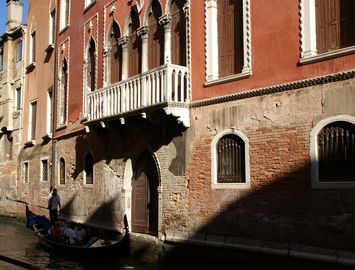

This enormous, heterogeneous palace, also known simply as Ca' Bragadin-Carabba, was built in the 15th century in the gothic manner. It was reconstructed in the 16th century by the famous Veronese architect, Michele Sanmicheli. Shaped like the letter "L" today the palace houses many individual apartments, as well as a Bed and Breakfast. But in the days of the Most Serene Republic it belonged to one of the most outstanding families of the Venetian nobility, the Bragadin.
The Bragadin family traces its lineage all the way back to the foundation of Venice in the 8th century. In fact, several sources say that one of their forefathers was Orso Ipato, Venice's first Doge. It produced a number of outstanding statesmen and military leaders, one of whom was Marcantonio Bragadin, hero of Famagusta during the War of Cyprus against the Ottoman Empire in 1571. Two hundred years later one Giovanni Bragadin obtained the highest post in the republic's religious hierarchy, that of Patriarch.
Yet, the Bragadin who is associated with this palace, and who happens to be one of the last family members to reside in it, was Matteo Bragadin, renowned orator, state inquisitor, senator, Cabalist and patron of Giacomo Casanova. It was in 1746 when the 55-year-old statesman, after leaving an all-night wedding party on the other side of the Grand Canal, encountered the 21-year-old libertine. Bragadin suddenly fell ill and started losing consciousness when Casanova ran up to him, slipped him into a gondola, rushed him to the palace and employed the most unorthodox remedy to heal him. After recovering, Bragadin could not believe that this young, poor, unknown violinist had such profound knowledge of medicine. No doctor had ever been as wise and helpful. Casanova had saved his life and Bragadin felt eternally grateful. Immediately the senator and the rake became inseparable friends, or rather, Bragadin became Casanova's adoptive father, since Casanova's natural father had died when he was eight years old. Being the adopted son of Senator Matteo Bragadin also meant enjoying all the privileges of Venice's patrician class. Casanova had his own gondola and gondolier, his own apartment within the palace; he wore the most elegant clothes, ate the most exquisite foods, drank the most expensive wines, gambled in the finest casinos, mingled with the most interesting people and frolicked with the most beautiful courtesans. His allowance was limitless. Bragadin had told him to enjoy life, and Casanova paid great heed to his adoptive father's advice. Not a moment was ever dull, not a lira was ever unspent. Casanova made pleasure his mission.
Yet, not every patrician in Venice looked favorably upon this relationship between a nobleman and a pauper musician. In fact, some were outraged. The government was informed about Bragadin and Casanova's cabalistic practices, an activity that was prohibited by law, and Casanova suddenly noticed that he had become a target not only for courtesans, but also for a tireless retinue of spies. His every movement was watched, his every escapade was reported to the state inquisitors, the secret police. Bragadin told him to leave Venice for a while in order to defuse the tension, which he did. But upon returning, Casanova found himself in a new scandal involving two nuns and the French ambassador. He was also discovered in possession of a prohibited religious book. Eventually, his amoral, anti-conformist and licentious behavior landed him in jail; and the only thing that Bragadin could do for him now was have him transferred to a more comfortable cell and provide him with decent food, clean linen and entertaining read. When Casanova finally escaped from the Leads, the prison on the top floor of the Doge's Palace, he fled the republic thinking that he would never be able to return. For the next eighteen years Casanova wandered the European continent. He went everywhere from France to England, to Russia and Spain. All this time Bragadin would send him money and letters of reference to influential aristocrats. But the two would never meet again.
Finally, Casanova was given official permission to return to his native city. But things had drastically changed. Bragadin had passed away several years earlier and thus Casanova had lost his inexhaustible source of income. He had also lost his charm and vigor - he was now fifty years old and world-weary. To make ends meet Casanova, the eternal chameleon, changed colors once more, but this time radically. He became a spy for the state inquisitors, in other words, he conformed to the establishment; he became the establishment.
In 1807, after Venice had been annexed by the French empire, Bragadin's palace was sold to the Carabba family, who then sold it to the Papadopoli family seventy years later. Bragadin, who had died in 1767, was most likely buried in the Church of Santa Marina, which stood on the campo in front of the palace, but was destroyed on orders of Napoleon Bonaparte.